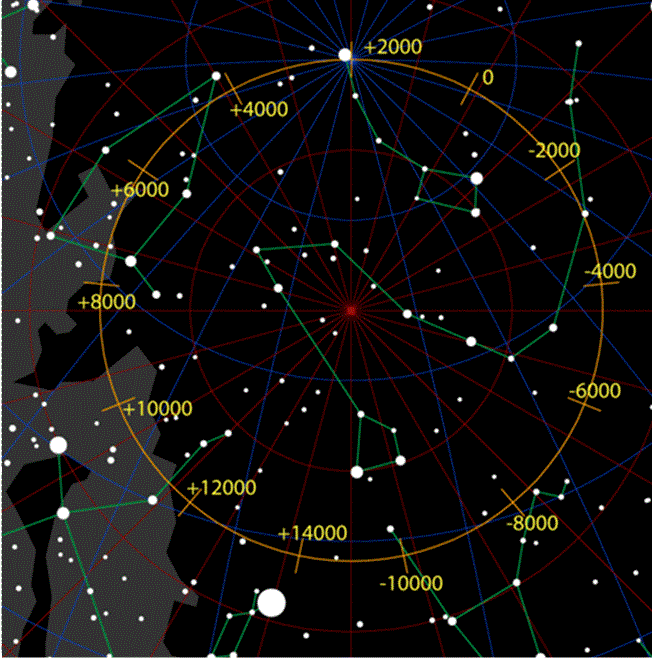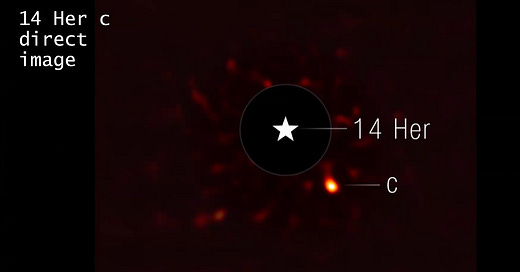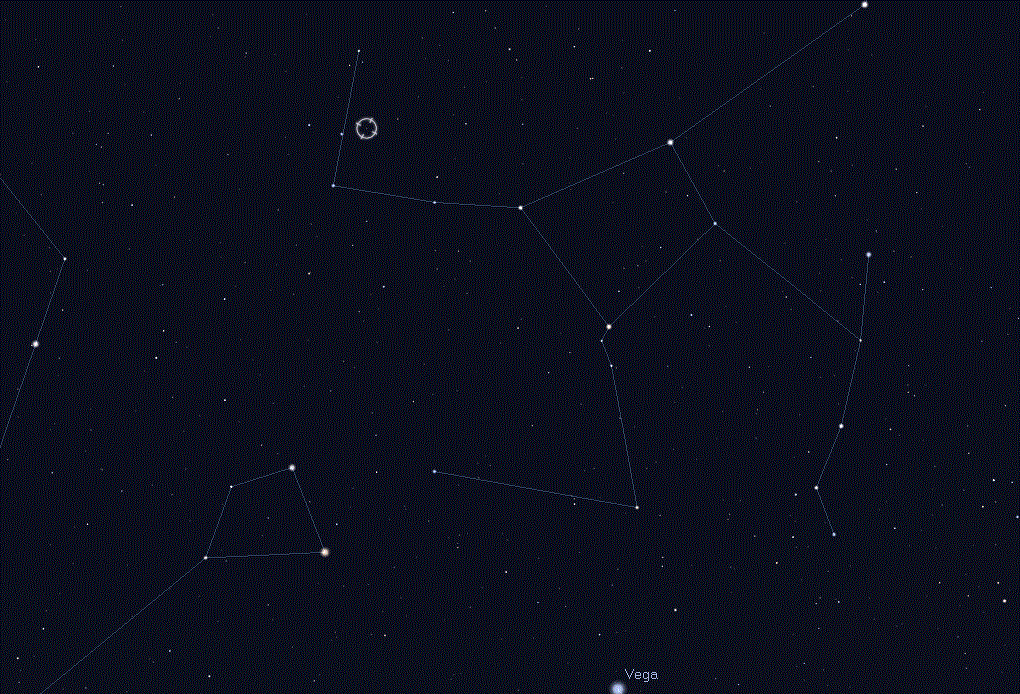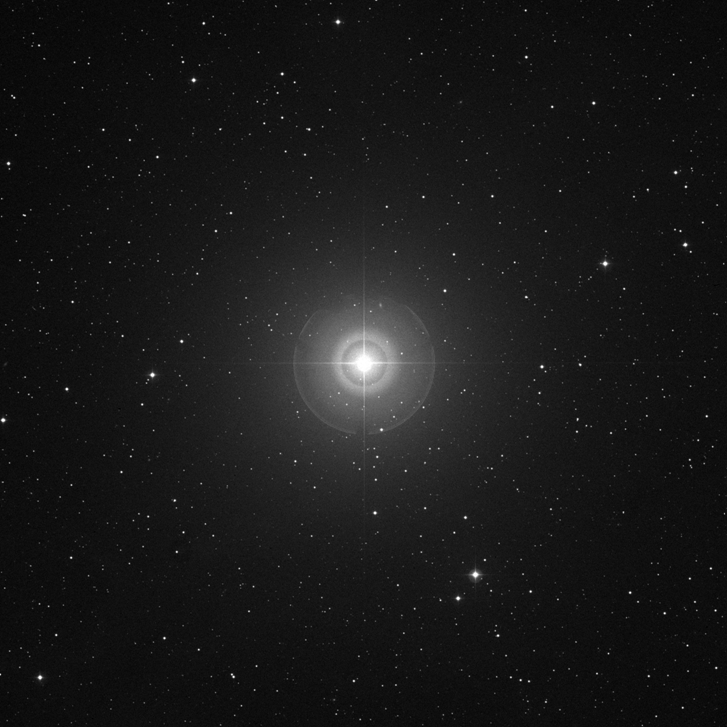TGT #25J - Calendar Summary Debuts - Book Preview - An Ice-Cold Jupiter
TGT 6/16/25: SPC: Moon, Mercury, Mars and Stars Variously Align-Saturn Hangs with Neptune-New SPC Summary Calendar!; L A U N S Preview; TJI: A Cold and Windy Jupiter in Hercules.
Cover Photo - Direct Image of a *Cold* Jupiter
In This Issue:
Cover Photo — Direct Image of a *Cold* Jupiter
This Just In - Cloudy with a Chance of Wind (Cover Story)
Welcome to Issue #25J!
Sky Planning Calendar —
* Moon-Gazing - Moon Straight-Line Aligns With Planets and Stars
* Observing—Plan-et - Saturn Hangs With Neptune
* NEW! - Calendar SummaryNEW! - Book Preview - Learning Astronomy Under the Northern Stars
Welcome to The Galactic Times Newsletter-Inbox Magazine #25J!
Greetings, Galactic Timers!
A first story from the American Astronomical Society meeting just concluded, about a star you can see in the sky tonight, and a Jupiter you can’t see that is also one of the coldest exoplanets ever discovered.
- - - - -
The evening sky is mostly moonless except at the very end of the month when things get a little interesting. The Moon, Mercury and the stars Castor and Pollux form a straight line (or lines, on separate dates) and later the Moon, Mars and Regulus do the same. How to tell Mars from Regulus when they are the same brightness? Different colors. Saturn spends its time hanging close by its giant planet buddy Neptune, all month.
- - - - -
Two new features in this issue. We are still doing narratives for the above sky phenomena in Sky Planning Calendar, but a Calendar Summary, a line-by-line combined calendar listing of events, has been added. Second, a Book Preview column, for one of yours truly’s new astronomy books that will come out this Fall; the column premieres with the opening chapter, based upon its original prose from The Classroom Astronomer magazine article. Click a link there to get put on the mailing list for announcements on its availability!
- - - - -
Do you want to get these issues right away in your mail inbox? Then subscribe. We don’t put the latest issue up on the Substack webpage until a week later.
* Not a Subscriber? Want to read this off the Web? Please hit the link..right… below:
Enjoy!
Publisher — Dr. Larry Krumenaker Email: newsletter@thegalactictimes.com
This Just In
Cloudy With a Chance of Wind
At a press conference this week at the American Astronomical Society (AAS) meeting in Anchorage, Alaska, William Balmer of John Hopkins University and the Space Telescope Science Institute announced an unusual exoplanet discovery, around a star that is currently visible in our evening sky, 14 Herculis. Halfway to the zenith while rising out of the Northeast at 9 PM, this dim star lies NW of the Keystone of Hercules (upper left as they all rise) and contains a rarity. Many of the thousands of exoplanets discovered are ‘hot Jupiters’, many times larger and considerable degrees hotter than our own giant world. But this star, which harbors at least two gas giants, has one that is cold!
Not only that, but the two gas giants, labeled b and c, orbit the star in wildly misaligned orbits, mostly perpendicular to each other!
The spectra from James Webb Space Telescope of the system indicate that c is one of the coldest exoplanets discovered, that there appear to be water-ice clouds and strong winds that push those clouds high off the surface. Why are the planets not in a similar orbital plane, like in the Sun’s system? Apparently, the 14 Her system is very dynamic for a solar-age star and c was kicked out of its original orbit but not hard enough to escape the system.
Sky Planning Calendar
Moon-Gazing
Moon passages by a star, planet or deep sky object are a good way to find a planet or other object if you’ve never located it before.
°°°°°°°°
June 18 Last Quarter Moon. Additionally, the half-moon later passes 3° from Saturn (and Neptune, but the latter will be all but invisible in the bright moonlight).
June 22 The Moon passes a mere 0.6° North of the winter star cluster Pleiades (M45), in the dawn sky.
June 23 Perigee is today, largest diameter Moon of the month, making the morning crescent a Super-Crescent Moon.
June 25 New Moon.
June 27 Mercury is 3° from the Moon.
June 29 Not only is Regulus 1.5° from the Moon, but Mars gets passed much closer by Luna, 0.2° away. The planet actually gets occulted by the Moon, for persons in Hawaii. Time for an astro-tropical vacation?
Observing---Plan-et
==The Gemini twin stars, Castor and Pollux, the Moon, and Mercury all do a do-si-do in various straight line matchups in the Evening Twilight. Ditto for Mars, Moon and Regulus.==
==Saturn and Neptune pal around together for days.==
==The Solstice occurs along with a bunch of 'earliest’ and ‘latest’ events.==
Mercury has an interesting distinction right now. It is the closest planet to the Sun (Duh!) but also the closest planet to the Earth! With Venus, the usual closest neighbor, having rounded the Sun and heading away from us towards a solar conjunction behind the Sun in a few months, it is actually farther from us than Mercury, and physically behind the little world.
Mercury in Earth skies is bright, magnitude -0.3, and at a greatest brilliancy for the rare *second* time in an apparition, below the first-magnitude star Pollux low in the evening twilight sky. For most of the month it sets about 90 minutes after the Sun sets. It actually has straight-line alignments that will make it easier to find: On the 24th there’s a straight line left to right (in the Northern Hemisphere) from Mercury to Pollux to Castor. Two days later, on the 26th, the Moon squeezes through between Mercury and Pollux, making an alignment of four celestial objects. It is actually closer to Mercury on the next night, 27th, but that view is reserved for Central Asians.
Venus, had reached its greatest distance-elongation-from ol’ Sol, 46 degrees. Despite that, it rises less than 30 minutes before morning twilight begins. It also is shrinking in apparent size and getting fuller in phase so in a telescope it isn’t very impressive.
Earth begins its “solstice period” with a bunch of “earliests”. We passed the Earliest Sunrise just before this Issue’s date. Coming up are the Earliest Morning Twilight start on the 17th (all these for Northern Hemisphere viewers—reversed for Southerners), the actual date of the Solstice is the 20th for North Americans, at 8:42AM but on the 21st for Europeans and longitudes east (2:42 AM for London), the latest end of Evening Twilight is on the 24th, and Latest Sunset on the 27th.
Mars glows dimly in the first dark shades of post-evening twilight, but not for long, setting no more than an hour after that twilight ends, and that time is steadily shrinking. Still, it is owed a few special notices. It passes close by the star Regulus on the 26-27th. [Both planet and star have the exact same brightness, +1.4, when they pass less than 1° from each other.] Then it makes a nice straight alignment on the 28th, Mars - Regulus - and the Moon. Mars and Luna pass closest on the 29th, actually occulted for Hawaii observers.
Jupiter isn’t visible, passing behind the Sun on the 24th. See you in a month…..
Saturn is the brightest night-time planet, though not too impressively, and the only one up until just before dawn begins once Saturn rises after both midnight and Mars’ setting. Saturn, still close to ringless, has an interesting conjunction this month….with Neptune. It passes about 1°from the farthest planet on the 29th , notably visible as a slightly greenish star and a very tiny disk in medium to high telescope powers. Both move so slowly that that distance hardly changes all month. Interestingly, Neptune is a faint magnitude +7.9 but Saturn’s brightest moon, Titan, nearby is nearly identical at +8.3. Can you see them both? At its farthest from Saturn’s disk, Titan is easily visible in even small scopes, such as a 2.4-inch refractor commonly available in stores.
Calendar Summary
16 Mars passes Regulus
17 Earliest Morning Twilight start
18 LAST QUARTER; Saturn 3°S of Moon
20 SOLSTICE 8:42 PM CDT (2:42 AM UK, tomorrow)
22 Moon 0.6° N of M45 in the Dawn
23 Super-Crescent Moon (i.e. the Moon is at Perigee, closest to the Earth, today)
24 Most in a line today, Mercury – Pollux – Castor; Jupiter in solar conjunction;
Latest start of Evening Twilight
25 NEW MOON
26 Mercury – Moon – Pollux – Castor, alignment; Mars passes Regulus
27 Latest Sunset
28 Aligned Mars – Regulus - Moon
29 Regulus 1.5° from the Moon; ~2AM Saturn 1° S of Neptune; Mars 0.2° from the Moon in evening
30 Mercury’s Second Greatest Brilliancy in this evening apparition, rare!; Mars sets about an hour after evening twilight ends.
Book Preview - Learning Astronomy Under the Northern Stars
As mentioned in the last issue of The Galactic Times, I am working on finishing two astronomy books, one of which is tentatively entitled Learning Astronomy Under the Northern Stars and is based on a set of 8 column-articles I wrote for the original The Classroom Astronomer Magazine (2009-2015). A subtitle might be ‘The 365-Night Astronomy Resource Book.” But these eight columns will be updated somewhat, and will be augmented in the book with about an equal number of extra “articles”. The idea is that to teach a variety of astronomical concepts at night you need resources up in view no matter when your course or study takes place. January or July. The only such resources are (for most of you readers of TGT) the North Circumpolar Stars. Given appropriate celestial objects, one can learn about star brightnesses (magnitudes), angles and coordinates and constellations for locating them, astrophysics of stellar colors and spectra, galactic structure and objects beyond the rim, and stellar evolution, among other topics. As long as they are visible whenever you need them, not just a particular month or season, this book will guide you.
Below is a copy (reformatted and slightly edited for Substack) of the original first article as it appeared in the Fall 2012 issue of the magazine and as it will be (more or less) in the new book!
* * * * *
Chapter One: Circling Around the Pole
The sky changes, we all know that. But the changes are mostly in the southern part of a Northern hemisphere sky. There is a part where things do not change significantly and this can be an advantage for a teacher. If you concentrate on stellar astronomy, then the northern part of the sky will always contain objects you can use to teach those concepts, and which will be there all year long.
First we need to define what part of the northern sky we are talking about!
What Part Of North Circumpolar Do You Want?
A common concept taught is circumpolarity. A constellation is considered circumpolar if it, by definition, never sets i.e. is always above the horizon. However, your latitude on Earth has some say in this. If you just happen to run the school that teaches astronomy to Santa’s elves (talk about a weird form of home-schooling!) then everything above you is circumpolar! Santa doesn’t subscribe to The Galactic Times so we’ll not consider that part of Earth here. On the other hand, if you are doing outreach at some equatorial observatory, nothing is circumpolar.
For an object to be circumpolar means it must be within the zone of the sky that can pass under Polaris (or more precisely, under the North Celestial Pole, the NCP). This means its distance from the NCP is also equal to 90 degrees minus your latitude. We would like circumpolar to be something special so we will define the limit farthest from the North Celestial Pole as where half the visible sky at your location never sets and half rises and sets. This maximum would be at latitude 45 degrees North. Now we have an international subscriber base but most of our subscribers are in North America, where the population density starts around latitude 45 North and drops off again near the US-Mexico-the Gulf states border, roughly latitude 30 degrees North. This means everybody between these two latitudes will see everything in the sky circumpolar if it is at a declination of 60 degrees North to the Pole. By the time we go to the northern latitude limit, the zone expands to include the sky between declinations 45 and 60 degrees North (we’ll discuss declinations in a bit).
For this book we will define the North Circumpolar Zone (NCZ) as all those objects found between declinations +60 to +90. Here we find Ursa Minor, of course. The bulk of Draco is here as well and so is a large part of the head and body regions of Ursa Major. Cepheus the King rules in this zone and his queen Cassiopeia straddles the border. The faint constellation of Camelopardalis finishes the population of the zone. A small fragment of the Milky Way just laps over the border as well.
The outlying area of declinations +45 to +60 we will call the North Circumpolar Border (NCB). The ‘square degrees’ here is much larger than that of the NCZ, and rather more interesting and diverse objects are available to see—sometimes—for some. Here we have the upper parts of the fall and winter constellations of Perseus, Auriga and Lynx. The rest of Ursa Major and Cassiopeia are available for teaching usage. Leftover from summer are the top part of Cygnus, almost all of the lizard Lacerta, many of the galaxies in Canes Venatici, and small upper fragments of other constellations such as Hercules and Bootes.
As we proceed with the chapters, we will prioritize the objects in the order here, on the assumption that something always visible to all is better than something not always visible to some.
Having defined what is “circum,” we should move onto the “polar” part. So let us begin with what to most observers is the Pole. That would be the star Polaris a.k.a. Alpha Ursa Minoris, a.k.a. the Pole Star.
As Constant As The Northern Star … NOT!

The colloquial wisdom, and the astronomy we often teach, especially at lower grade levels, is that Polaris is the North Star because “it doesn’t move.” It is constant in its location and brightness. That’s actually wrong on at least three levels. First, Polaris hasn’t always been the Pole Star; in fact, it wasn’t within even 4 degrees of the North Celestial Pole until around 1000 AD, barely a millennium ago. Even now, it is not there...and it never will be on top of the NCP. It will get only as close as about 0.4 degrees, just under a Full Moon’s diameter away. Thus, second, it is not constant in position every night, it does move in a circle around the actual Pole, currently a circle about 1.4 degrees in diameter. You can see that in the bright, tiniest semi-circular trail in the center of the photograph on the book cover.
Third, Polaris has quite a personality for a ‘constant’ star. For instance, its brightness hasn’t been constant either. There is historical evidence that Polaris has been brightening over the past 2000 years. Currently it is visual magnitude +2.0, making it around the 50th brightest star. It certainly isn’t the brightest star in the sky, although that is a common misconception, too! But in the times of Ptolemy (around 200 BC), and al-Sufi almost a 1000 years later, it was listed as faint as (in modern units) magnitude 3.5. Next, even on shorter time scales, Polaris varies, because it is a particular kind of pulsating variable star called a Cepheid. So it gets a little brighter and little dimmer on a regular periodic basis, about every 4 days, a period growing longer 4 seconds per year. The magnitude range currently is only 0.02 yet in the past the range appears to have been as high as 0.1. A constant star? Hardly. Still, it does hold the place of honor as the brightest and nearest of all Cepheid variables, about 433 light years away, with roughly a 10% uncertainty factor. The light we see tonight left Polaris just 56 years after Nicolas Copernicus, creator of the modern heliocentric theory, died and around three decades before the English began to colonize North America. This was also the time when both Galileo and Kepler did their telescopic and planetary motion things.
The basics—Polaris is about 2000 times more luminous than our Sun. If brought to 10 parsecs (32.6 light years) away from us, the distance in which we measure all stars’ absolute magnitudes or absolute brightnesses, it would be magnitude –3.6, almost as bright as Venus. It is a spectral type F8 Ib+II, meaning it is a little bit hotter and slightly more towards the white end of yellow stars than our Sun, and a giant star. The mass is about 4-5 solar masses, gravity 100 times stronger than the Sun’s, and about 46 times the Sun’s radius. Polaris is making its first trip off the Main Sequence, where all stars shine during the longest stage of their lives, expanding and cooling as it ages towards a red-giant phase. Don’t worry if the terms don’t mean anything yet; they will when we are done.
Polaris isn’t alone. It has at least one orbiting companion, revolving around the main, bright star every 30 years, and one other star as well. That last star, an optical double, is called Polaris B, but B doesn’t share the motion of star A. Speaking of traveling, there has been suggested it belongs to a Pleiades moving star group but that notion appears squashed.
In almost every culture and language, this star’s name usually means “important” or “major star” or something similar. Among the Inuits the name is Nuuttuittuq and it means “never moves.” No matter what language you speak, Polaris is one of the stars one needs to learn.
- - - - -
Author Note: To be added to this article in the book will be some information on the lore of the constellations involved, too, and a deep-space look at what we would learn looking towards the North Celestial Pole, using the Gaia mission data.
Are you interested in reading more of the book? Send a DM in the chat link on the TGT Substack website to yours truly, or click this link (I WANT THIS BOOK!) to send an email to get on the mailing list for an announcement of the book’s availability this Fall! -LK








